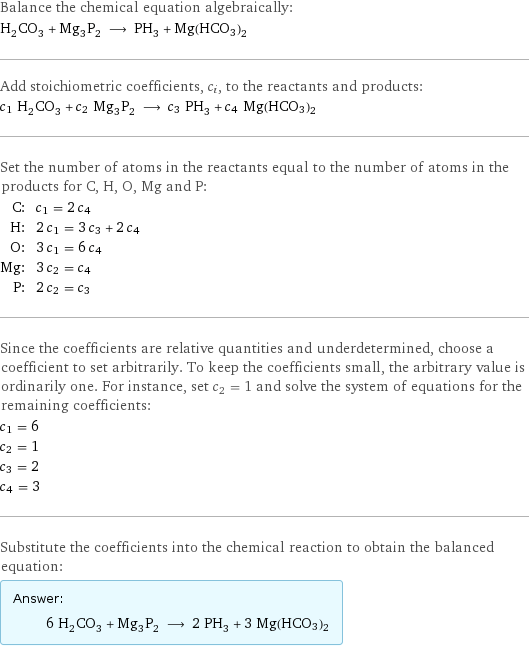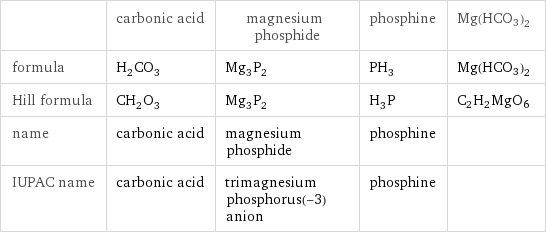Input interpretation

H_2CO_3 carbonic acid + Mg_3P_2 magnesium phosphide ⟶ PH_3 phosphine + Mg(HCO3)2
Balanced equation

Balance the chemical equation algebraically: H_2CO_3 + Mg_3P_2 ⟶ PH_3 + Mg(HCO3)2 Add stoichiometric coefficients, c_i, to the reactants and products: c_1 H_2CO_3 + c_2 Mg_3P_2 ⟶ c_3 PH_3 + c_4 Mg(HCO3)2 Set the number of atoms in the reactants equal to the number of atoms in the products for C, H, O, Mg and P: C: | c_1 = 2 c_4 H: | 2 c_1 = 3 c_3 + 2 c_4 O: | 3 c_1 = 6 c_4 Mg: | 3 c_2 = c_4 P: | 2 c_2 = c_3 Since the coefficients are relative quantities and underdetermined, choose a coefficient to set arbitrarily. To keep the coefficients small, the arbitrary value is ordinarily one. For instance, set c_2 = 1 and solve the system of equations for the remaining coefficients: c_1 = 6 c_2 = 1 c_3 = 2 c_4 = 3 Substitute the coefficients into the chemical reaction to obtain the balanced equation: Answer: | | 6 H_2CO_3 + Mg_3P_2 ⟶ 2 PH_3 + 3 Mg(HCO3)2
Structures

+ ⟶ + Mg(HCO3)2
Names

carbonic acid + magnesium phosphide ⟶ phosphine + Mg(HCO3)2
Equilibrium constant
![Construct the equilibrium constant, K, expression for: H_2CO_3 + Mg_3P_2 ⟶ PH_3 + Mg(HCO3)2 Plan: • Balance the chemical equation. • Determine the stoichiometric numbers. • Assemble the activity expression for each chemical species. • Use the activity expressions to build the equilibrium constant expression. Write the balanced chemical equation: 6 H_2CO_3 + Mg_3P_2 ⟶ 2 PH_3 + 3 Mg(HCO3)2 Assign stoichiometric numbers, ν_i, using the stoichiometric coefficients, c_i, from the balanced chemical equation in the following manner: ν_i = -c_i for reactants and ν_i = c_i for products: chemical species | c_i | ν_i H_2CO_3 | 6 | -6 Mg_3P_2 | 1 | -1 PH_3 | 2 | 2 Mg(HCO3)2 | 3 | 3 Assemble the activity expressions accounting for the state of matter and ν_i: chemical species | c_i | ν_i | activity expression H_2CO_3 | 6 | -6 | ([H2CO3])^(-6) Mg_3P_2 | 1 | -1 | ([Mg3P2])^(-1) PH_3 | 2 | 2 | ([PH3])^2 Mg(HCO3)2 | 3 | 3 | ([Mg(HCO3)2])^3 The equilibrium constant symbol in the concentration basis is: K_c Mulitply the activity expressions to arrive at the K_c expression: Answer: | | K_c = ([H2CO3])^(-6) ([Mg3P2])^(-1) ([PH3])^2 ([Mg(HCO3)2])^3 = (([PH3])^2 ([Mg(HCO3)2])^3)/(([H2CO3])^6 [Mg3P2])](../image_source/bb6ebd955b88db5888f30c87de019c79.png)
Construct the equilibrium constant, K, expression for: H_2CO_3 + Mg_3P_2 ⟶ PH_3 + Mg(HCO3)2 Plan: • Balance the chemical equation. • Determine the stoichiometric numbers. • Assemble the activity expression for each chemical species. • Use the activity expressions to build the equilibrium constant expression. Write the balanced chemical equation: 6 H_2CO_3 + Mg_3P_2 ⟶ 2 PH_3 + 3 Mg(HCO3)2 Assign stoichiometric numbers, ν_i, using the stoichiometric coefficients, c_i, from the balanced chemical equation in the following manner: ν_i = -c_i for reactants and ν_i = c_i for products: chemical species | c_i | ν_i H_2CO_3 | 6 | -6 Mg_3P_2 | 1 | -1 PH_3 | 2 | 2 Mg(HCO3)2 | 3 | 3 Assemble the activity expressions accounting for the state of matter and ν_i: chemical species | c_i | ν_i | activity expression H_2CO_3 | 6 | -6 | ([H2CO3])^(-6) Mg_3P_2 | 1 | -1 | ([Mg3P2])^(-1) PH_3 | 2 | 2 | ([PH3])^2 Mg(HCO3)2 | 3 | 3 | ([Mg(HCO3)2])^3 The equilibrium constant symbol in the concentration basis is: K_c Mulitply the activity expressions to arrive at the K_c expression: Answer: | | K_c = ([H2CO3])^(-6) ([Mg3P2])^(-1) ([PH3])^2 ([Mg(HCO3)2])^3 = (([PH3])^2 ([Mg(HCO3)2])^3)/(([H2CO3])^6 [Mg3P2])
Rate of reaction
![Construct the rate of reaction expression for: H_2CO_3 + Mg_3P_2 ⟶ PH_3 + Mg(HCO3)2 Plan: • Balance the chemical equation. • Determine the stoichiometric numbers. • Assemble the rate term for each chemical species. • Write the rate of reaction expression. Write the balanced chemical equation: 6 H_2CO_3 + Mg_3P_2 ⟶ 2 PH_3 + 3 Mg(HCO3)2 Assign stoichiometric numbers, ν_i, using the stoichiometric coefficients, c_i, from the balanced chemical equation in the following manner: ν_i = -c_i for reactants and ν_i = c_i for products: chemical species | c_i | ν_i H_2CO_3 | 6 | -6 Mg_3P_2 | 1 | -1 PH_3 | 2 | 2 Mg(HCO3)2 | 3 | 3 The rate term for each chemical species, B_i, is 1/ν_i(Δ[B_i])/(Δt) where [B_i] is the amount concentration and t is time: chemical species | c_i | ν_i | rate term H_2CO_3 | 6 | -6 | -1/6 (Δ[H2CO3])/(Δt) Mg_3P_2 | 1 | -1 | -(Δ[Mg3P2])/(Δt) PH_3 | 2 | 2 | 1/2 (Δ[PH3])/(Δt) Mg(HCO3)2 | 3 | 3 | 1/3 (Δ[Mg(HCO3)2])/(Δt) (for infinitesimal rate of change, replace Δ with d) Set the rate terms equal to each other to arrive at the rate expression: Answer: | | rate = -1/6 (Δ[H2CO3])/(Δt) = -(Δ[Mg3P2])/(Δt) = 1/2 (Δ[PH3])/(Δt) = 1/3 (Δ[Mg(HCO3)2])/(Δt) (assuming constant volume and no accumulation of intermediates or side products)](../image_source/f3a86ebfd1281e7d7857442e9af9750a.png)
Construct the rate of reaction expression for: H_2CO_3 + Mg_3P_2 ⟶ PH_3 + Mg(HCO3)2 Plan: • Balance the chemical equation. • Determine the stoichiometric numbers. • Assemble the rate term for each chemical species. • Write the rate of reaction expression. Write the balanced chemical equation: 6 H_2CO_3 + Mg_3P_2 ⟶ 2 PH_3 + 3 Mg(HCO3)2 Assign stoichiometric numbers, ν_i, using the stoichiometric coefficients, c_i, from the balanced chemical equation in the following manner: ν_i = -c_i for reactants and ν_i = c_i for products: chemical species | c_i | ν_i H_2CO_3 | 6 | -6 Mg_3P_2 | 1 | -1 PH_3 | 2 | 2 Mg(HCO3)2 | 3 | 3 The rate term for each chemical species, B_i, is 1/ν_i(Δ[B_i])/(Δt) where [B_i] is the amount concentration and t is time: chemical species | c_i | ν_i | rate term H_2CO_3 | 6 | -6 | -1/6 (Δ[H2CO3])/(Δt) Mg_3P_2 | 1 | -1 | -(Δ[Mg3P2])/(Δt) PH_3 | 2 | 2 | 1/2 (Δ[PH3])/(Δt) Mg(HCO3)2 | 3 | 3 | 1/3 (Δ[Mg(HCO3)2])/(Δt) (for infinitesimal rate of change, replace Δ with d) Set the rate terms equal to each other to arrive at the rate expression: Answer: | | rate = -1/6 (Δ[H2CO3])/(Δt) = -(Δ[Mg3P2])/(Δt) = 1/2 (Δ[PH3])/(Δt) = 1/3 (Δ[Mg(HCO3)2])/(Δt) (assuming constant volume and no accumulation of intermediates or side products)
Chemical names and formulas

| carbonic acid | magnesium phosphide | phosphine | Mg(HCO3)2 formula | H_2CO_3 | Mg_3P_2 | PH_3 | Mg(HCO3)2 Hill formula | CH_2O_3 | Mg_3P_2 | H_3P | C2H2MgO6 name | carbonic acid | magnesium phosphide | phosphine | IUPAC name | carbonic acid | trimagnesium phosphorus(-3) anion | phosphine |
Substance properties

| carbonic acid | magnesium phosphide | phosphine | Mg(HCO3)2 molar mass | 62.024 g/mol | 134.86 g/mol | 33.998 g/mol | 146.34 g/mol phase | | solid (at STP) | gas (at STP) | melting point | | 750 °C | -132.8 °C | boiling point | | | -87.5 °C | density | | 2.055 g/cm^3 | 0.00139 g/cm^3 (at 25 °C) | solubility in water | | reacts | slightly soluble | dynamic viscosity | | | 1.1×10^-5 Pa s (at 0 °C) |
Units
